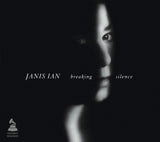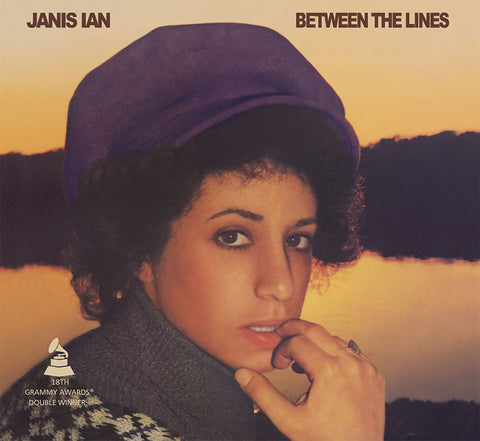As featured in the award-winning American Masters film "Janis Ian: Breaking Silence"!!
This is an audiophile CD, remastered from the original analog source tapes, with new cover art to reflect changed credits (Rude Girl Records/Janis Ian now own this) and its Grammy nomination!
You can also go to CD quality digital download and MP3 digital download . If you prefer, you can also purchase a digital download or stream by going here, though honestly, we'd rather you purchased from us!
Tracks:
- All Roads To The River
- Ride Me Like A Wave
- Tattoo
- Guess You Had To Be There
- What About The Love
- His Hands
- Walking On Sacred Ground
- This Train Still Runs
- Through The Years
- This House
- Some People's Lives
- Breaking Silence
- Ride Me Like A Wave (Bonus Cut! Wet Mix (Dance))
- This Train Still Runs (Bonus Cut! Live With Band!)
* the last two cuts may not be reflected in the artwork, but they are there!
See below for SACD and vinyl versions!
The Basics: Produced by Janis Ian & Jeff Balding; recorded 1992 in Nashville; released worldwide 1993. This "comeback" album, Janis' first in a decade, received wonderful reviews and a Grammy nomination "Best Contemporary Folk Album - Breaking Silence". (Ironically, Janis lost the Grammy to her friend Nancy Griffith, whose album Other Voices Other Rooms featured Janis and Jon Vezner's song "This Old Town.") "Some People's Lives" became the title song of a double-platinum album for Bette Midler; "What About the Love" was featured on a platinum album by Amy Grant. "All Roads To the River" was recorded for the film Falling From Grace with John Mellencamp producing, and charted top 30 on the Gavin Chart; it was also recorded by Mellencamp himself under the title "To the River". Last but not least, "Tattoo" was chosen by the government of Holland to represent their country in European festivities celebrating the 50th anniversary of World War II end. Grammy nominee; voted Album of the Year by the Nashville Music Awards.
Inside Scoop: Breaking Silence has been out of print since two years after its release in 1993. Thanks to the generosity of Jim Robinson and Greg Mielcarz, those rights now belong to Janis. Because of this, we are able to re-issue the Grammy-nominated album worldwide! Our site features the CD as originally mastered for audiophile use, a hi-res download at (16bit, 44.1kHz) or an mp3 download at (320Kbps).
Rather than the usual "inside scoop", we asked both Janis and co-producer/engineer Jeff Balding to tell us, verbatim, what they remembered about the recording:
Janis: It was my first record back after 10 or 11 years away, so it was very make it or break it. My wife and I took out a second mortgage to finance this record, because no one wanted it. We had next to no budget - Jeff kept careful track on his Mac in a spreadsheet he created, and we split what was left over at the end. My feeling was that if the record ought to be made, things would fall into place as they should, without a lot of hassle on our part. And that's what happened! First, I was originally going to use a different producer, someone very well known at the time who my business advisors thought would help convince a record company to release it. (He's since passed away.) I met with him at a local breakfast place. I'd sent him about 20 songs to choose from, assuming he'd listen and give recommendations. However, during our meal he informed me that he would not listen to anything in advance and called me "girlie". When I demurred, he asked me "Who the hell do you think you are?" at the top of his lungs, bringing me to tears. Eventually, as he berated me, I left the restaurant in tears. I called my business manager at the time, who said basically that I should tough it out - an attitude my wife disagreed with completely.
A mutual friend risked a great deal to stop by my house after this incident, and quietly let me know that this producer had described his plan for working with me as "I'm going to war with Janis Ian, and I'll break her".
After I heard that, of course, I fired him. Since Jeff was his preferred engineer, I investigated, liked what I heard of his work, took him out to lunch, and asked if he'd co-produce and engineer my project. So, lemons into lemonade.
Further to the "things fall into place", I hired a really good company to design the cover, led by Virginia Team, a multiple Grammy-winning designer. She showed me dozens of ideas and photographer's portfolios, but none were right. One day, shortly after she'd shown me yet another portfolio, Jeff and I were in the studio (Emerald, I think) when someone came in and said "Is that your car parked outside? the one the big U-Haul truck just totalled?" I ran outside to see a truck with California plates backing out of my car, which now resembled an accordion. The driver and I traded information, and I asked why she was in Nashville. "Oh, I'm a photographer's rep, pitching one of my photographers" she said. The photographer happened to be sitting next to her. I asked to see the portfolio, and it was perfect. Lisa Powers then did the photography for Breaking Silence, and later for Billie's Bones. Again, lemonade from lemons.
As noted, we barely had a budget, so we worked on alternatives. For instance, we built a "guitar booth" by putting me in a small completely enclosed area (with glass, so I could see Jeff and the band), then lining the walls on all sides with my various instruments. Depending on the song, and the effect we wanted from the guitar - which was the driving force behind the music most of the time - we'd move the guitars around so that, for instance, the Jimmy D'Aquisto all maple dreadnaught's back was set up right in front of me for portions of "Tattoo", and the bounce off it gave my playing guitar a "pingy" sound. We really stayed as organic as possible, from using devices like that to recording completely analog, straight to tape.
Outside of Jeff's brilliant engineering (the absolute best I'd worked with since Brooks Arthur in his heyday, when we cut "Society's Child" and many years later "At Seventeen"), Doug Sax was an enormous help. He loaned us tons of equipment, cut us a lot of slack financially, and was a ready and willing ear throughout. His mastering added the final icing on the cake to the project.
And remember, this was all before the "DIY" world really began happening. In 1992 or so, for an artist to self-fund an album meant either they sucked and no one else would touch it, or they were independently wealthy and doing it as a vanity project. So it was pretty unusual from the start.
Jeff Balding (engineer, co-producer): Here's what I remember of it. We recorded it at Seventeen Grand Studio which at the time and a Helios console in it. They're great sounding consoles. Many say they have the open top end of an old Trident A Range and the fat bottom of an old Neve. A little history of the console, this Helios in particular was the same one used on the old Seals and Croft records. Anyway, in addition we also had a lot of vintage gear that I owned including a Fairchild 670, which ended up being used on the bass and some of the percussion tracks. We did the basic tracking at Seventeen Grand and yes, Janis is right that we did surround her with acoustic guitars sitting on their stands. The room itself wasn't bad, but we were really sensitive to how an instrument reacts in the room and tried to be creative in how we treated that.
Many overdubs and much of the percussion was recorded at Dugout Studio, which is now called Vibe 56. This studio is an old house with 12-14 foot ceilings and has some characteristics of the old Bennett House Studio. The Bennett House was an amazing place to record. The old house sounded amazing. Most everything was recorded through vintage preamps, Neve, Langevin, and Telefunkin. We used vintage Pultec Eq's, Fairchild compressors etc. The vocal mic we used was a very sweet sounding Telefunken U-47 and I believe I used a Telefunken V76M mic pre. No EQ and no Compression. Vintage gear can vary in quality of sound, so there might be one mic out of 50 vintage U-47's that sounds sweet. I think we had that mic and that preamp. Plus, Janis has an amazing voice and knows how to sing in the studio, how to work the mic and how to bring the best of what she does across on tape.
And yes, this was a 16 track analog recording.
We mixed at Bill Schnee's studio, which is an amazing sounding studio. The console is custom made and sounds like no other. You just bring the fader up and you hear everything you want to hear out of that track. If you choose to eq it's only to add a color to the sound. Not to try to get it to where it sounds like you think it should before you decide if you want to color it. So because the studio was amazing and we took great care in getting the sounds for the recording, things just came up sounding like we imagined they would.
During the mixing process I also mic'd the studio and used it as an echo chamber for certain instruments. Because Schnee's room sounds amazing, I was able to create more space in the sound of the record.
* Side note: When I mix something like this, I always mix from a visual perspective, I want to see where the placement is as well as hear it.
Bill also has an amazing-sounding tube plate which I used. We mixed down to an amazing sounding Ampex ATR102 analog 2 track. Then took it to Doug Sax who is absolutely astonishing. His gear and his ear are amazing. So Doug added a whole new dimension to this record. There wasn't one person or one thing involved who didn't make important contribution to how this recording turned out.
Digital version of the original songbook for this album available!
You can also purchase very high resolution copies of Breaking Silence from Acoustic Sounds, including SACD, Vinyl, Gold CD, and reel-to-reel!
Now live for order here:













